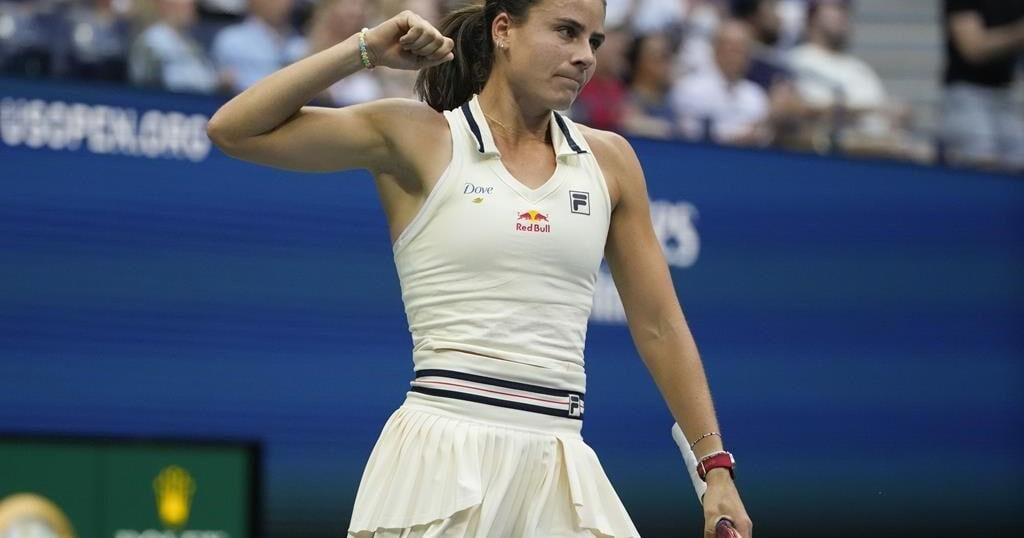NEW YORK (AP) — This is pretty much all anyone needs to know about defending champion Coco Gauff’s 6-3, 4-6, 6-3 loss to Emma Navarro in the U.S. Open’s fourth round on Sunday: Gauff wound up with more double-faults, 19, than winners, 14.
The No. 3-seeded Gauff had won 10 matches in a row at Flushing Meadows, including the run to her first Grand Slam title a year ago.
Four of those came after she dropped the opening set — including in the 2023 final and in her third-round victory on Friday — but the 20-year-old from Florida could not complete the comeback this time. That’s despite a mid-match, four-game run in which she claimed 14 of 17 points to steal the second set and get off to a good start in the third.
“Had a little bit of a lull there,” said the 13th-seeded Navarro, an American who was 0-2 at the U.S. Open until this year, “but I was able to regroup … and come into the third set with a fresher mindset.”
After each of her past two contests in New York, Gauff headed back out onto the practice courts to work on her serve. That didn’t help much on Sunday, when she tied her career high for double-faults: She also had 19 in a loss at the 2020 French Open. Against Navarro, Gauff delivered a trio of double-faults in three different games — two of which she lost, at 1-all in the first set and, more significantly, at 1-all in the third.
Eleven of the double-faults came in the final set alone.
Aside from those issues, Gauff finished with a total of 60 unforced errors — a whopping 29 on her forehand side, the biggest weakness in her game. The 23-year-old Navarro, who also eliminated Gauff in the fourth round at Wimbledon in July, was far steadier on Sunday and had 35 unforced errors.
“Coco’s an amazing player, and I have a ton of respect for her,” said Navarro, a U.S. teammate of Gauff’s at the Paris Olympics, “and I know she’s going to come back and win this thing again one year.”
This result follows the surprising third-round loss by defending men’s champion Novak Djokovic on Friday night, meaning the lengthy droughts without anyone winning consecutive titles in New York will continue. The last woman to win at least two in a row was Serena Williams with three from 2012-14; the last man to do so was Roger Federer with five from 2004-08.
The Wimbledon win over Gauff earned Navarro, the 2021 NCAA singles champion for the University of Virginia, her first appearance in a major quarterfinal. Her second will come Tuesday in New York against No. 26 Paula Badosa, a 6-1, 6-2 winner against Wang Yafan.
Earlier Sunday, with 23-time Grand Slam champion Williams watching in Arthur Ashe Stadium and offering a thumbs-up at match’s end, No. 9 men’s seed Grigor Dimitrov held off Andrey Rublev 6-3, 7-6 (3), 1-6, 3-6, 6-3 to get to the quarterfinals.
The No. 6-seeded Rublev is known for violent displays of frustration, and he needed medical attention from a trainer for a cut on his left hand after hitting it against his racket in the first set. He slapped himself in the face during a meltdown in the second-set tiebreaker, which he led 3-1 before losing the next six points.
Dimitrov now faces No. 20 Frances Tiafoe or No. 28 Alexei Popyrin, the player who stunned Djokovic on Friday.
Also moving on Saturday was No. 12 Taylor Fritz, who beat three-time Grand Slam finalist Casper Ruud 3-6, 6-4, 6-3, 6-2. Fritz’s quarterfinal opponent will either be another American, Brandon Nakashima, or 2020 U.S. Open runner-up Alexander Zverev of Germany.
“I’m at the point now where I’m still happy to make quarterfinals, but I wouldn’t be happy with it ending here,” said Fritz, who has yet to reach a Grand Slam semifinal. “I definitely am at the point where I really want more than that.”
___
AP tennis:
